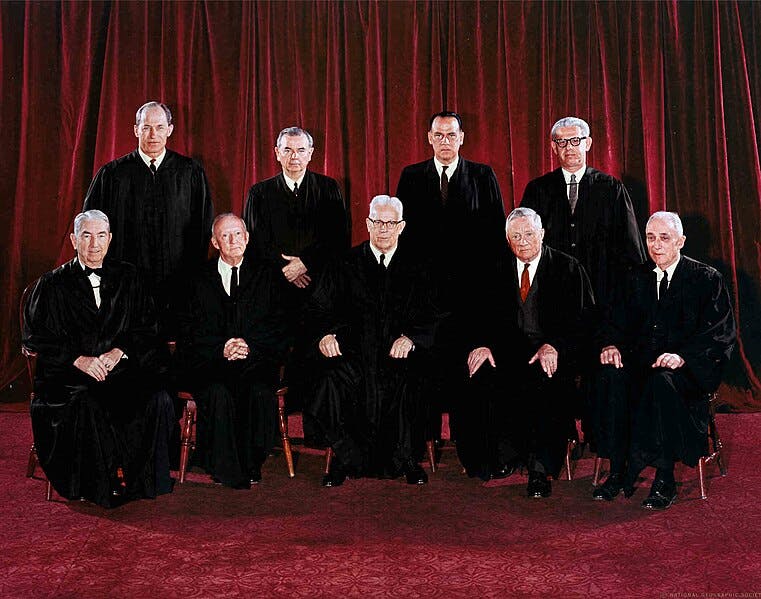The Liberal Warren Court Could Have Written the Supreme Court’s Recent ‘Conservative’ Opinions
Today, most justices tend to elevate their political and ideological views over enduring constitutional values.

The three contentious decisions announced near the end of the Supreme Court’s recent term regarding Blacks and affirmative action, gays and the First Amendment, and student loan forgiveness — all could have been rendered by the liberal Warren court of the 1960s.
President Biden criticized the current Supreme Court as not being “normal” — by which apparently meant not like previous High Courts. The historical record does not support that conclusion.
I clerked on the Supreme Court during its most liberal term, 1963-1964. I feel sure that at least five of its members, including its liberal chief justice, Earl Warren, and Associate Justices William Douglas, Hugo Black, and Arthur Goldberg (for whom I clerked) would have supported the results, if not all the reasoning, in these three cases. So would some of the moderates, such as Justices Potter Stewart, John Harlan, and Tom Clark.
On Black preferences in admission, the liberal view back then was that race as such could not constitutionally be taken into account by a state actor. Douglas, perhaps the court’s most liberal jurist, expressed this view clearly in his separate opinion in the case of DeFunis v. Odegaard written in 1974.
Douglas and other liberal jurists believed that economic and other non-racial factors could be taken into account, but not race itself. Stewart, a moderate, explicitly agreed with that position.
On the issue of whether the government could compel a web or cake maker to express views with which she disagrees, the liberal view was that the First Amendment generally trumps public accommodation laws.
This would have been regarded as a close case by liberal justices but I believe they would have come down, as many civil libertarians today have come down, on the side of the first amendment. This decision too represents the liberal mainstream.
Finally on the decision regarding student loans, the liberal view has generally been to prefer that the legislative, rather than the executive, branch make fundamental decisions regarding the expenditure of government funds.
Liberal justices would have probably sided with the current court in concluding that Congress must be crystal clear in allocating legislative functions to executive bureaucrats.
In all three cases, the liberal justices of the 1960s would have been unhappy with the actual consequences of these three cases on political and ideological grounds. They would personally have favored the admission of more Blacks to universities, the protection of gays, and the forgiveness of student loans.
Yet they would have subordinated their political and ideological views to what they regarded as the mandates of the Constitution. Back in the day, both liberal and conservative justices often joined decisions in which their constitutional views clashed with their political ones. In general, they favored the Constitution.
This has now changed considerably. Today, most justices tend to elevate their political and ideological views over enduring constitutional values. This is true of both liberals and conservatives, and indeed each side claims they are doing it to offset the partisanship of the other side.
The end result of this change has been to weaken the constitution and to delegitimize the court in the minds of many objective observers. The current justices are far more result-oriented than their predecessors. And support and criticism for their decisions are result-oriented as well.
Too few today care about neutral principles that favor neither party nor any ideology. They demand results and they demand them now. It doesn’t matter to them whether these good outcomes are the result of legislative, executive or judicial decisions.
What seems to matter more are their personal and political views on whether more Blacks are admitted, more gays are protected, and more students are assisted. This may be understandable but it is inconsistent with the role of judges.
The reason why unelected, lifetime appointed judges are given power to overrule the decisions made by the elected legislative and executive branches, is that the Supreme Court is supposed to decide issues based on enduring nonpartisan principles that are rooted in the language and meaning of the Constitution.
The Supreme Court is not supposed to be a super-legislature or executive, authorized to overrule decisions with which they disagree politically or ideologically. The politicization of the Supreme Court undercuts the unique functions of the judiciary.
It is not enough to say that each side is reacting to the overreaching of the other side. Two constitutional wrongs make a constitutional fight, not a right. They do not serve larger interests of American citizens in the rule of law.
The cause of this politicization of the judiciary lies primarily in the process by which justices (and other judges) are currently nominated and confirmed. There was a time when the main criteria for appointment was the judicial temperament and legal ability they exhibited.
Today, anticipated outcomes come first. How will the justice vote on abortion, gun control, and other agenda-driven issues? The quality of their opinions is secondary.
The only cure lies in the appointment process. Presidents and the Senate must return to a time reflected by President Hoover’s appointment of Benjamin Cardozo to replace Justice Oliver Wendell Holmes.
Hoover asked his attorney general to prepare a list of the 10 most qualified judges in America. The list included Cardozo, but he was at the very bottom. Hoover told the attorney general that it was a great list, but it was upside down.
He then appointed Cardozo despite his being a Democrat from a state that already had more than one justice. Cardozo served with distinction, never allowing his partisan or ideological views to prevail over the Constitution.
It may be wishful thinking to believe we could ever return to those days, but all Americans would benefit if current presidents and senators followed Hoover’s non-partisan lead in appointing justices.
The alternative is an increasingly partisan Court that will continue to be perceived as just another political branch of government, but without the legitimacy of having been elected.
A small portion of this column is based on an op-ed published in the Wall Street Journal on July 11, 2023.

